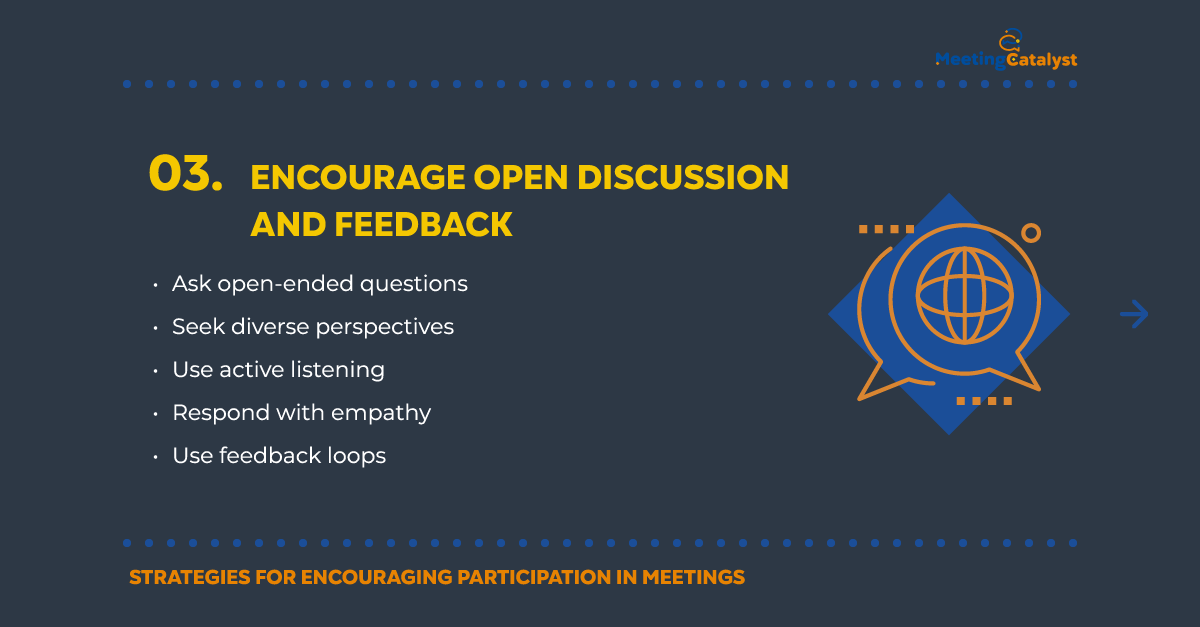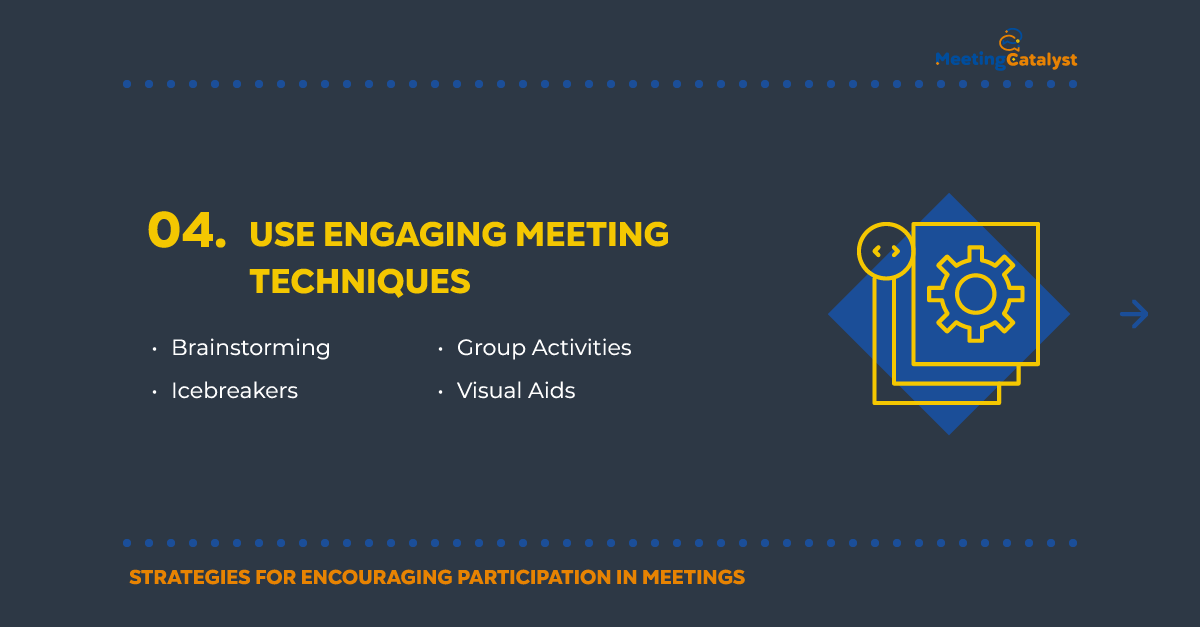How to Encourage Participation in Your Meetings

Introduction
Meetings are an essential part of business life, providing an opportunity for teams to collaborate, share ideas, and make decisions. However, the success of these meetings is highly dependent on the level of participation from all attendees. When everyone is actively engaged, it leads to a richer exchange of ideas, more informed decisions, and, ultimately, better outcomes for your organization.
To help you encourage participation in your meetings, this article will guide you through various strategies and tips that can transform your sessions into dynamic, collaborative events. We will cover the following key areas:
- Setting the tone for participation
- Providing clear agendas and objectives
- Encouraging open discussion and feedback
- Using engaging meeting techniques
- Following up and following through
By incorporating these strategies into your meeting practices, you can create an environment where everyone feels encouraged to contribute, leading to more productive and effective meetings. So, let's dive in and explore how you can foster active participation in your next meeting.
Set the Tone for Participation

Creating a positive and inclusive meeting environment is critical for encouraging participation. When attendees feel comfortable and valued, they are more likely to share their ideas and engage in discussions. Below are some strategies for setting the tone for participation in your meetings:
Lead by Example: As a meeting leader, your behaviour sets the stage for the rest of the group. Demonstrate active listening, maintain eye contact, and show genuine interest in others' opinions. This will signal to attendees that their input is valued and encourage them to participate.
Establish Ground Rules: At the beginning of the meeting, outline the expectations for participation. For example, you could emphasize that everyone's ideas are welcome and interruptions should be avoided. Clearly stating these ground rules helps create a safe space for open communication.
Acknowledge Contributions: When attendees share their thoughts, acknowledge their input and thank them for their contribution. This positive reinforcement encourages others to participate and creates an atmosphere of respect and appreciation.
Promote a Positive Atmosphere: Encourage a supportive environment by addressing any negative behaviour, such as dismissive comments or personal attacks. Reinforce the importance of constructive feedback and respectful communication.
Encourage Equal Participation: Make an effort to include quieter attendees by asking for their input directly or creating opportunities for them to speak. This will show that everyone's perspective is valued and encourage more balanced participation.
Real-life examples of successful implementation:
- A team leader at a software company starts each meeting by acknowledging the recent achievements of team members, fostering a sense of appreciation and camaraderie.
- A manager at a marketing agency sets ground rules that include "One person speaks at a time" and "No idea is a bad idea" to create a supportive environment for brainstorming sessions.
- A project lead at a construction firm rotates the responsibility of leading meetings among team members to ensure everyone has a chance to contribute and be heard.
By setting the right tone for participation, you create an environment where everyone feels comfortable sharing their thoughts and ideas, leading to more effective and collaborative meetings.
Provide Clear Agendas and Objectives

Clear agendas and objectives are essential for encouraging participation in meetings. They help attendees understand the purpose of the meeting, what they are expected to contribute, and how their input will be used. Here are some strategies for creating effective agendas and objectives:
Define the Purpose: Start by clearly outlining the purpose of the meeting. This will help participants understand the goals and context of the discussion, enabling them to contribute more effectively.
Create a Detailed Agenda: A well-structured agenda provides a roadmap for the meeting, allowing attendees to follow along and know when their input is needed. Include specific topics, timeframes, and discussion leaders for each agenda item.
Distribute the Agenda in Advance: Share the agenda with all attendees well before the meeting. This gives participants the opportunity to prepare for the discussion, gather their thoughts, and come ready to contribute.
Set Clear Objectives: Outline the desired outcomes of the meeting and what you hope to achieve by the end of the session. Clear objectives give attendees a sense of direction and help focus their contributions.
Allow for Agenda Flexibility: While it's essential to have a structured agenda, be open to adjusting it if new topics or ideas arise during the meeting. This flexibility encourages attendees to voice their thoughts and fosters open dialogue.
Real-life examples of successful implementation:
- A sales manager at a retail company shares the agenda for their weekly team meeting two days in advance, allowing team members to prepare their sales updates and suggestions.
- A non-profit organization's board of directors provides a detailed agenda with time allocations for each discussion item, ensuring all topics are covered, and participants know when to contribute.
- A software development team lead sets clear objectives for their sprint planning meeting, such as defining the upcoming sprint's goals and assigning tasks to team members.
By providing clear agendas and objectives, you give attendees a sense of purpose and direction, empowering them to participate more effectively in your meetings.
Encourage Open Discussion and Feedback

Fostering open discussion and feedback is crucial for maximizing participation in meetings. By creating an environment where attendees feel comfortable sharing their thoughts, you can tap into diverse perspectives and generate valuable insights. Here are some strategies for promoting open discussion and feedback:
Ask Open-Ended Questions: Encourage participation by asking open-ended questions that require more than a simple "yes" or "no" answer. This will prompt attendees to think more deeply and share their thoughts.
Seek Diverse Perspectives: Actively seek out input from individuals with different backgrounds, experiences, and roles within the organization. This diversity can lead to a richer, more nuanced discussion.
Promote Psychological Safety: Create a meeting atmosphere where attendees feel safe to express their ideas without fear of judgment or ridicule. Encourage respectful disagreement and emphasize that all opinions are valuable.
Acknowledge and Validate Contributions: When someone shares an idea or feedback, acknowledge their input and thank them for their contribution. This positive reinforcement encourages others to participate as well.
Address Dominant Voices: If one or two individuals are dominating the conversation, gently redirect the discussion to ensure everyone has an opportunity to contribute. Encourage quieter attendees to share their thoughts.
Real-life examples of successful implementation:
- A project manager at a marketing firm asks open-ended questions during meetings, such as "What are some alternative approaches we could consider for this campaign?"
- A team leader at a financial services company invites team members from different departments to attend brainstorming sessions, bringing diverse perspectives to the discussion.
- An executive at a technology start-up encourages team members to share their ideas and concerns during meetings, fostering an environment of psychological safety and open dialogue.
By encouraging open discussion and feedback, you can create a meeting atmosphere that promotes active participation and collaboration, ultimately leading to more effective decision-making and problem-solving.
Use Engaging Meeting Techniques

Incorporating engaging meeting techniques can significantly boost participation and make meetings more productive. By employing creative activities and interactive methods, you can encourage attendees to think outside the box, collaborate, and share ideas more freely. Here are some strategies for using engaging meeting techniques:
Brainstorming: Utilize brainstorming activities to generate a wide range of ideas from all attendees. Encourage participants to share their thoughts without judgment, and remember to capture all ideas for future reference.
Group Activities: Break the meeting into smaller groups or pairs to tackle specific tasks or topics. This approach can encourage more intimate discussions and help quieter attendees feel more comfortable sharing their thoughts.
Icebreakers: Use icebreaker activities to help attendees loosen up and feel more comfortable participating. These activities can also foster rapport and trust among team members, promoting better collaboration during the meeting.
Visual Aids and Tools: Incorporate visual aids like whiteboards, flip charts, or digital collaboration tools to help participants organize their thoughts and share ideas more easily.
Interactive Presentations: Instead of relying solely on traditional presentations, encourage presenters to make their sessions interactive by asking questions, soliciting feedback, or incorporating activities that involve the audience.
Real-life examples of successful implementation:
- A design team at an advertising agency uses brainstorming sessions to come up with creative ideas for new campaigns, involving all team members in the process.
- A software development company holds regular "hackathons" where employees break into small groups to work on innovative projects, fostering collaboration and idea-sharing.
- A nonprofit organization starts its monthly meetings with a fun icebreaker activity to help team members feel more relaxed and connected before diving into the agenda.
By incorporating engaging meeting techniques, you can create a more dynamic, interactive environment that encourages participation and stimulates creative thinking. This, in turn, can lead to more productive and enjoyable meetings for all involved.
Follow Up and Follow Through

Establishing a practice of follow-up and follow-through after meetings is essential for maintaining momentum, ensuring accountability, and encouraging continued participation. By demonstrating that actions and ideas discussed during the meeting are taken seriously, you can motivate team members to stay engaged and contribute in future meetings. Here are some strategies for effective follow-up and follow-through:
Provide Meeting Minutes: Summarize the key points, decisions, and action items from the meeting in a clear, concise format. Distribute the meeting minutes to all attendees, allowing them to review the content and stay informed about the progress made during the session.
Assign Action Items and Responsibilities: Clearly designate who is responsible for each action item and establish deadlines for completion. This helps ensure that tasks are completed in a timely manner and holds individuals accountable for their commitments.
Track Progress: Regularly review the status of action items and follow up with team members to ensure they are making progress. Offer support and resources as needed to help them overcome any obstacles or challenges.
Celebrate Success: Acknowledge the successful completion of action items and celebrate the accomplishments of team members. This positive reinforcement can motivate individuals to continue participating and contributing in future meetings.
Solicit Feedback: Ask attendees for feedback on the meeting, including what went well and what could be improved. Use this feedback to refine and enhance future meeting experiences, ensuring that they remain engaging and productive.
Real-life examples of successful implementation:
- A project manager at a construction company sends out detailed meeting minutes after each weekly meeting, ensuring all team members are on the same page and understand their responsibilities.
- A marketing team leader assigns action items to each team member during their monthly strategy meeting and follows up with individuals to track progress and offer support as needed.
- A human resources manager holds a post-meeting debrief session to gather feedback on a company-wide training session, using the insights to improve future training events.
By following up and following through after meetings, you can demonstrate the value of participation, maintain momentum, and foster a culture of accountability and collaboration. This, in turn, can lead to more effective and engaging meetings that drive results and keep team members actively involved.
Conclusion
Encouraging participation in meetings is crucial for driving innovation, collaboration, and overall team success. By creating an inclusive atmosphere, providing clear agendas and objectives, fostering open discussion, using engaging techniques, and following up and following through, you can create a meeting environment that inspires team members to contribute their ideas and insights actively.
In this article, we've explored various strategies for fostering participation in your meetings and real-life examples of successful implementation. As a business or team leader, it's essential to adapt these strategies to your unique team dynamics and continuously refine your approach based on feedback and experience.
By implementing the tips outlined in this post, you can transform your meetings into more engaging and productive experiences, ensuring every participant feels heard and valued. Now it's time to put these strategies into action and empower your team to contribute, collaborate, and achieve better results together.